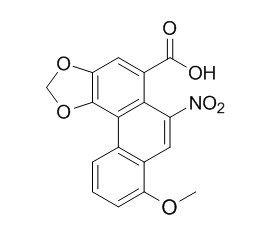Natural Products
Aristolochic acid A
| Catalog No. | CFN99505 |  |
| CAS No. | 313-67-7 | |
| Molecular Weight: | 341.27 | |
| Molecular Formula | C17H11O7N | |
| DBs | [PubChem]:274950648 [ChEMBL]:2825 [PCIDB]: |
Standard InChI:
InChI=1S/C17H11NO7/c1-23-12-4-2-3-8-9(12)5-11(18(21)22)14-10(17(19)20)6-13-16(15(8)14)25-7-24-13/h2-6H,7H2,1H3,(H,19,20)
Biological Activity
Aristolochic acid, a potent human carcinogen produced by Aristolochia plants, is associated with urothelial carcinoma of the upper urinary tract (UUC), exposure to aristolochic acid contributes significantly to the incidence of UUC in Taiwan and endemic (Balkan) nephropathy .[1]
DNA damage by aristolochic acid (AA) is not only responsible for the tumour development but also for the destructive fibrotic process in the kidney; AA is a powerful nephrotoxic and carcinogenic substance with an extremely short latency period, not only in animals but also in humans, therefore, all products containing botanicals known to or suspected of containing AA should be banned from the market world wide.[2,3]
Aristolochic acid can induce proximal tubule apoptosis and epithelial to mesenchymal transformation.[4]
Aristolochic acid induces tumors in rats and mice, activates mutations at codon 61 of the c-Ha- ras gene in thin-tissue sections of tumors. [5]
Product
Official website: Aristolochic acid A
Japanese website: Aristolochic acid A
Chinese website: Aristolochic acid A
Japanese website: Aristolochic acid A
Chinese website: Aristolochic acid A
References
[1] Chen C H, Dickman K G, Moriya M, et al. P Nat Acad Sci US A, 2012, 109(21):8241-6.
[2] Grollman A P, Shibutani S, Moriya M, et al. P Nat Acad Sci US A, 2007, 104(29):12129-34.
[3] Arlt V M, Stiborova M, Schmeiser H H. Mutagenesis, 2002, 17(4):265-77.
[4] Pozdzik A A, Salmon I J, Debelle F D, et al. Kidney International, 2008, 73(5):595-607.
[5] Schmeiser H H, Scherf H R, Wiessler M. Cancer Letters, 1991, 59(2):139-43.
[6] Zhu G, Wang Z, Wang Q, et al. China Pharmacy, 2006, 17(18):21-4.
Product Use Citation





